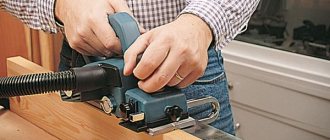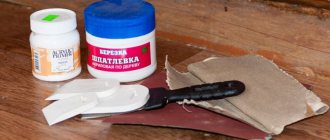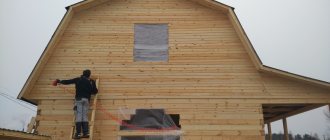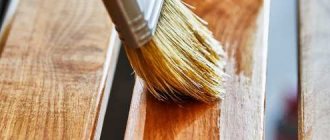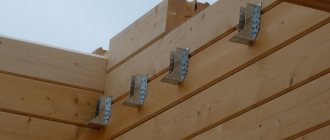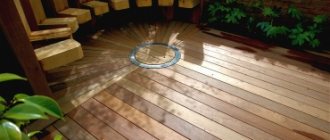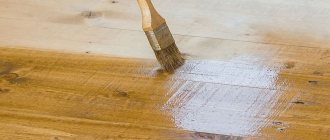The use of wood in construction is widespread throughout Russia. Forest, as an organic material, requires protection from insect pests, microorganisms, fungi, algae, and from environmental factors. For this purpose, wood antiseptic is used.
Wood antiseptic is used to treat wood so that fungi do not spread, causing harm to various types of lumber (timber, boards, lining, etc.), winds and precipitation do not create conditions for the reproduction and development of mold and fungi, and pest bugs cannot freely turn timber into dust.
Antiseptics are bioprotection for wood. The building materials market offers a wide selection of antiseptics, before purchasing which it is recommended to finally decide on the type of wood and type of lumber, its properties and area of application (external or internal, floor or walls, rafters or foundation, etc.), since different solutions have different influences and protect against various destructive factors.
Functions of wood antiseptic
Wood is treated with antiseptics to protect it from the destructive effects of both fungi (wood-staining and destructive, mold) and insect pests (bark beetles, termites, wood borers and others), as well as from the effects of aggressive natural factors (temperature changes, moisture, cold, winds etc.)
Bioprotection for wood is needed at all stages of logging and during processing for use in construction. Depending on the species of wood and types of lumber, the type of antiseptic and quantity will differ.
Bioprotection for wood is used as an impregnation or composition that applies a protective film to the surface of the forest from the harmful factors and organisms described above. At the same time, it is recommended to paint the wood after treating it with an antiseptic impregnation so that it does not evaporate. In addition to bioprotection for wood, after which painting of the treated surface is necessary, there are non-washable antiseptics for wood that reliably protect buildings and internal elements without the need for painting.
Additionally, some types of wood preservatives are used to treat lumber that is already infested. It is also important to treat damp wood with bioprotection to stop rotting and prevent the development of fungi and insect pests.
How often is antiseptic treatment performed?
Let's look at the example of private wooden houses. If the house is built using frame technology, then antiseptic treatment is performed at the stage of preparing lumber for use. Subsequently, the wood will be covered with various materials (waterproofing, windproofing, vapor barrier) and will not need repeated treatments.
Houses made of timber are treated with antiseptics for the first time after the period of most intense shrinkage. Before painting. In the future, the frequency of repeated treatments depends on what the frame was painted with. As a rule, you have to return to this issue no more than once every 5 years.
Types of antiseptics
When treated with bioprotection for wood, the color of the wood changes. This is used in room design when they want to get a color close to natural. This composition is called a decorative antiseptic.
Depending on the characteristics, antiseptics can be divided into the following groups of types:
- by composition;
- by area of application;
- by method of application;
- according to the degree of effectiveness.
Each group contains its own types of wood preservatives.
Types of antiseptics by composition
According to the type of substances that were used in the production of bioprotection for wood, it can belong to the following groups:
- Water-soluble antiseptics: they are usually used for prevention, that is, surface layers intended for use without contact with water are treated with such bioprotection. It is worth remembering that after treating the material with an antiseptic of a similar composition, it needs time to dry. Sometimes, after such a composition has been applied to timber, cracks may form on the wood; infrequently, even its modifications occur.
- Oil compositions are used where protection from contact with moisture is needed, and permanent protection. However, such impregnations have disadvantages, such as good flammability and a persistent unbearable odor. Also, when treated with such antiseptics, the color of the wood changes.
- Organic preparations: their compositions are produced on an organic basis. They are usually used where it is necessary to process wooden structures or parts both outside and inside buildings. After processing lumber with them, a thin film is formed that covers the entire outer layer of the tree. This film allows the wood to become water-repellent and improves its adhesion.
- Combined antiseptics that combine different qualities. Along with bioprotection for wood, they also perform a fire retardant function, that is, they protect the material from fire and are called fire retardants.
Types of biosecurity by area of application
Based on the area of application, there are two types of bioprotection:
- Preparations used to treat lumber inside buildings. After using such substances, a coating is formed on the treated material, which does not allow toxic substances to evaporate and enter the air. This detail is essential for the bioprotection of wood, which is used in residential buildings, as it protects wooden structures without harm to human health. It is worth saying that these antiseptics are quite stable, and the treated materials do not require annual re-treatment. However, depending on what the room is intended for, the types of bioprotection for wood may be different. For example, when processing wooden materials in a room where constant humidity and heat are expected, it is worth choosing solutions designed for steam rooms. Before purchasing, it is recommended that you first read the documents that come with it. If the biosecurity is of good quality, then all documents that meet the requirements of harmlessness to humans and animals will be available.
- Antiseptics for external treatment are compositions used to antisepticize lumber intended to be located outside buildings. Since timber is located outside buildings, it is expected that it will regularly be exposed to environmental ravages. Therefore, for protection, it is worth giving preference to reliable and high-quality antiseptics that will help the tree resist harmful factors. They are characterized by a strong, nasty odor that disappears after the wood is completely dry. Usually, this smell disappears after a month or two. Such antiseptics are highly hydrophobic and resistant to sunlight, but they are completely unsuitable for use inside buildings. There are 2 types of antiseptics for external use, and there is also a mixed one:
- compositions that can penetrate deeply into the layers of wood and destroy microorganisms and insect pests, or impregnations;
- finishing coatings are compositions for the protection of lumber, characterized by the application of an impregnating layer that does not allow useful substances to erode. They are not designed to penetrate deeply into the layers of wood, but form a thin film on the outer layer of lumber that protects from external influences.
- mixed or combined drugs are antiseptics that provide several protections at the same time.
Before choosing an antiseptic, it is recommended to read the instructions, find out the specifics of use, safety precautions and information about the composition. The market offers types of bioprotection that, after treatment, can cause harm to building materials with which they come into contact. Also, their compounds can poison the environment due to their toxicity.
Types of antiseptics by method of application
Antiseptics also differ in the method of application. In most cases, there are 2 fundamental techniques in mind. One is surface application, which requires a special pump, rollers or brushes; application using a spray gun is possible; application methods using diffusion and the capillary method are also possible. The other, deep, is characterized by complete immersion of timber in a solution, hot or cold. When deeply impregnating wood, much depends on the type of wood and its part. For example, dry pine heartwood is poorly saturated with antiseptics without heating them (up to 100 ℃). Processing in an autoclave under high pressure or using vacuum is also common. Additionally, the method of bandage treatment of wood with bioprotection is used.
It is preferable to impregnate dry lumber with organic or aqueous antiseptics, but some of them will be difficult to place on the surface layer of the tree. If raw wood is stored without drying, it is easy to treat it with an aqueous antiseptic solution. You just need to saturate the damp wood with an antiseptic. During the processing process, disinfectants will react with the internal moisture of the tree. The most easily impregnated wood species are beech, birch and pine.
Types of antiseptics by degree of effectiveness
Each type of biocontrol is designed to combat specific wood problems. There are also antiseptics that can eliminate existing diseases.
According to the degree of effectiveness relative to the degree of damage to the tree:
- light (clean wood, not affected by mold or mildew),
- medium (minor damage),
- strong (significantly affected by fungus or mold, can be modified). Each type requires the use of a special composition of the drug.
Also, bioprotection for wood varies in degree of effectiveness, expressed in the level of productivity in the fight against fungi and insects. Highly effective antiseptics provide the tree with reliable protection against almost all pests and reduce the risk of wood damage.
Types of antiseptics by functionality
All types of bioprotection for wood can also be divided according to their functional effect. Among the problems from which antiseptics protect timber, the following can be identified:
- violation of wood storage conditions;
- bioprotection applied to wood at the wrong time;
- storage of lumber either in the absence of a ventilation system or in conditions of its inferiority;
- interaction of wood surface with water;
- use of low quality insulation and others...
Most types of antiseptics have a targeted effect on wood: they restore its color, increase its fire resistance (fire retardants), and treat damage caused by microorganisms and insects.
Choice of antiseptic
Before choosing bioprotection for wood during construction work, you should decide on the parameters described above: where the structure will be located (outside, inside), its tasks, the quality of the wood, part of the wood, species, and others. Inspect the lumber for lesions that need to be treated. If they are absent, think about what you plan to use the antiseptic for. And provide for everything that is planned from a wooden structure. You should also think about how to treat the wood: by applying a composition to the surface or by impregnation, and only then choose. At the same time, we should not forget about the different functional effects of such bioprotection for wood.
If the wood preservative is of good quality, its label will clearly describe the composition, information on the environmental friendliness and toxicity of the substance, as well as instructions for use. Additionally, it is accompanied by documents confirming the passage of laboratory tests and the conclusions of the sanitary and epidemiological station.
Silicone-based compounds, which have excellent moisture-repellent ability and good vapor permeability, have become popular antiseptics for wood.
It is also necessary to always consider what kind of structure is to be built. For example, for wood that will be in contact with the ground (foundation, log house and other buildings) or other moisture-containing materials, substances from the manufacturers Senezh and Neomid will be suitable. Such substances should be applied to wood in several layers, giving each layer at least seven hours to dry.
Further, there is a bioprotection for wood, which, when applied, changes the shade of the wood to light green and is not washed out during the operation of the structure. They use the natural moisture of the wood to ensure deep penetration. Similar types include “Senezh Eurotrans”, “Neomid 460”, as well as “Aquatex”.
If the roof truss system was built with flaws, then the wooden rafters must be treated with bioprotection. In this case, it is necessary to take into account the natural features of the area where the structure is being built: if the humidity is high, then it is necessary to protect the tree from fungi and mold; in a dry climate, protection from insect pests is required. It is not recommended to apply several different substances to one surface to avoid reaction with each other. The market offers the following antiseptics for the bioprotection of wood, effective in such cases: Olympus, Senezh, Drevotex and Rogneda.
If insect pests have already settled in a wooden structure or its surface has begun to be affected by mold and fungi, it is necessary to use preparations that not only protect against external influences, but are also capable of treating already affected areas. Almost all modern wood antiseptics are capable of not only protecting, but also fighting biological contamination. However, the following bioprotection products for wood are highlighted: a series of products from Tikkurila and paste for antiseptic treatment PAF-LST.
When constructing wooden structures indoors, it is necessary to choose antiseptics that are harmless to people, but effective in affecting biocontamination. Among the high-quality bioprotectants, products from Tikkurila stand out. Although recently the domestic Senezh and Neomid are in no way inferior to the leader in efficiency, they at the same time act in the economy segment, that is, they have a lower price.
For outdoor work, bioprotection from Pinotex is recommended. Often there is a need to treat wood that is old or already painted. To do this, antiseptics designed for this purpose are used, which create a protective layer on top of the paint. These include antiseptics “Waltti Techno” and “Homeenpoisto”.
Processing rules
When applying an antiseptic to wood, you should always adhere to safety precautions, the rules of which are always present in the documentation for it. Further, it should be remembered that there are substances and structures for which the application of an antiseptic must be carried out after a certain period of time (a year, two, etc.). It is also recommended that when treating structures with bioprotection, change the drug every period after its use. Microorganisms and insects can simply get used to the drug used and develop immunity.
Modern types of bioprotection for wood, as a rule, do not have a strong odor. To achieve the desired effect, it is recommended to treat the wood with them in several layers.
Before processing, make sure that the wood is clean and dry. To clean it, you should use an iron scraper. If cleaning is not possible, the use of a solvent is recommended. If the lumber is wet or frozen, you should refrain from processing, since in this form the impregnating ability of the antiseptic is significantly reduced. Before treating the entire surface of the wood, the already damaged areas, the sawing areas, are first treated. And then the drug is applied using the methods described above.
If the wood is damp, then the antiseptic can be applied either with a brush, roller or spray gun. Most drugs act as insect repellents, but do not completely destroy them. To completely destroy them, alcohol-based substances are used. They are injected with a syringe into the wormholes, and then the entire wood is processed.
Conclusion
In modern conditions, the use of wood antiseptics is justified and is an excellent way to ensure the durability of various buildings and other structures. These products successfully help to avoid the destruction of wood due to climatic and natural factors for this material. Wood preservatives are available in different forms - both for indoor and outdoor use. People who previously doubted the justification of using antiseptics have now gotten rid of their doubts. They saw that our products, when used correctly and following all the rules set out in the instructions, are safe for human health. If you use protective agents when applying them, they will in no way cause harm.
How to prepare bioprotection for wood at home
You can independently prepare biogen to protect lumber either on the basis of bitumen (resin) or on the basis of a salt-water mixture.
The first method or a mixture of bitumen for application to the surface of wood is effective against rot and pests. To prepare it, you need bitumen, as well as a diluting agent - gasoline or diesel fuel. It is thanks to diesel fuel that the preparation will harden longer and its penetration into the surface of the wood will be deeper. Gasoline, when used in a solution, can speed up the solidification process of the mixture. It should be used if construction work is limited in time.
You can buy bitumen solvents at every gas station, and used motor oil at service stations. Bitumen is sold either in construction stores or at construction sites. When purchased at a hardware store, bitumen has higher viscosity and good packaging, which increases its transportability.
When purchasing fuel at a gas station, you should always use metal containers, otherwise static discharge from other materials can lead to fire and varying degrees of burns.
In addition to the solution ingredients described above, in order to prepare an antiseptic with your own hands, you need additional equipment:
- a metal container to heat the bitumen;
- metal spatula for mixing the solution;
- stops to fix the container above the fire.
You can prepare a mixture based on bitumen as follows:
- Immerse bitumen in the container;
- place the container over the fire;
- heat until the bitumen is completely melted, stirring until the lumps dissolve;
- when the bitumen has a weak viscosity, remove the container from the heat and let it cool slightly;
- After cooling, mix the bitumen with a thinner, which is recommended to be added in small portions so that it does not evaporate.
The proportion of bitumen and solvent depends on the state in which the bitumen was initially found. An important measure is whether the resulting mixture remains fluid at a temperature of 18-20 °C. The share of fuel in the mixture is approximately twenty to thirty percent of the resulting volume of the composition. At the same time, the viscosity of bitumen has an effect on it, under which the composition percentage can change.
If the bitumen container is heated quickly, the mixture may overflow directly into the fire. The cause of overflow and bubbling of the mixture is water from the bitumen composition. When heated slowly, the mixture does not overflow and the water does not boil away. Based on the volume of lumber, it takes from two hours to a whole day to prepare a bitumen antiseptic. The resulting preparation has good viscosity and adhesiveness to the top layer of any wood. The resulting mixture is not stored for a long time, so it is used immediately after cooling.
It is recommended to make the bitumen preparation outdoors in order to reduce the likelihood of poisoning by toxic fumes to 0 and reduce the fire hazard. The resulting antiseptic must be applied with a brush or roller with a long handle. You can also impregnate lumber with it by simply immersing parts of the wood in a container with the mixture. Once the bitumen layer dries, it is difficult to disturb. Therefore, such structures are not afraid of contact with the ground.
Another way to prepare wood antiseptic yourself is to prepare a salt-water solution. This solution can be prepared through a chemical reaction between a certain amount of salt and water. To increase the catalytic activity of water, it is heated. As a result, an antiseptic preparation for processing timber is formed. There are different proportions for the antiseptic sodium fluoride and copper or iron sulfate:
- impregnation of lumber in buildings and domestic structures requires a weak mixture of sodium fluoride and water. The proportion of this substance relative to water will be 50-400 g per bucket. Additionally, when treating indoors, weaker mixtures are recommended for use, while outdoors it is worth using more concentrated solutions. To visually understand whether the drug has been completely applied, 10 grams of potassium permanganate are added to the solution. The bright color does not last long and will disappear once the surface is covered. This solution is applied either with a roller, or with a wide brush, or with a spray bottle.
- To treat wooden structures in contact with the ground, sulfate solutions are used with a sulfate content of 1-2 kg per bucket of water. To improve the effect of such mixtures, it is necessary that the lumber is dry and the impregnation is long-lasting. The application of an antiseptic can also be visually determined by the color saturation of the vitriol. Parts of the wood are soaked in the resulting antiseptic, which will subsequently be exposed to negative environmental influences.
To prepare an aqueous solution you will need hot water, a mixing container and a stirrer. You can use the mixture after it has settled and cooled, having previously loaded it into the spraying apparatus. It is spraying that allows you to evenly cover the surface of the wood with the mixture and reduce its consumption. In this case, the solution has a shelf life of several days; processing can begin when suitable weather conditions have established.
Such antiseptics can be prepared both indoors and outdoors. When preparing at home, you need to be careful and make sure that the antiseptic does not get on your clothes or in crevices with difficult access. This solution can be prepared for up to an hour.
To avoid errors when measuring proportions for the composition, you must first familiarize yourself with the characteristics of the wood that is to be processed.
Differences between hand-made antiseptics and ready-made ones from the factory
Among the advantages of self-made preparations for wood processing in comparison with purchased factory-produced analogues, the following can be identified:
- the cost is lower;
- if the treatment occurs with a bitumen or oil composition, then the effectiveness of the effect increases;
- less toxicity;
- the chance that the antiseptic will be of low quality is almost zero.
At the same time, they are inferior to factory-produced drugs:
- efficiency is higher with factory-made drugs;
- factory ones are easy to prepare, that is, if you follow the instructions, they can be quickly prepared by simply mixing with a solvent;
- Factory antiseptics have a selective effect on wood.
Fire retardants and antiseptics are required to protect wood so that buildings and structures last longer. You should not look for the best antiseptics for wood, but you should first understand what is expected from them, and only then choose. Each group has its own leaders.
Introduction
The use of wood as a raw material for the construction of various structures dates back to ancient times. Nowadays, most residential and non-residential buildings are made of wood. Residents of developed Scandinavian countries are now building 80 out of 100 wooden buildings.
A separate and very important area of use of natural wood is now considered the construction of saunas. A sauna is a device developed by the inhabitants of the northern countries, with the help of which people can undergo very pleasant procedures that serve the general health, strengthening and cleansing of the body. A sauna is not just an analogue of a Russian bath, but also one of the national symbols, attributes of the dignity of the northern peoples.
The healing effect of a sauna is achieved by warming the body with steam. Under these conditions, the interior lining of the sauna must be made from natural wood of the highest quality.
The birthplace of saunas is Finland. Since ancient times, this cold country has been famous for the fact that its inhabitants reverence a healthy lifestyle. Today, Finnish statistics may surprise a foreigner: there are 2 million saunas per 5 million inhabitants. Not just any wood is suitable for lining such a bathhouse - it must contain a minimum amount of resin. Oak and aspen are best suited in this case. In order for the finished bathhouse to be safe, easy to use and sufficiently durable, it is mandatory to treat the wood with an antiseptic. Nowadays it is simply impossible to find a sauna without such a coating.
In modern construction of any objects, wood is used very widely. It is a natural and noble material; its special qualities make it ideal for many jobs. Let's consider what properties are inherent in wood in general, and what types of wood are easiest to find in Russia.
